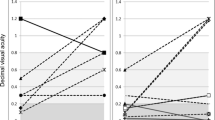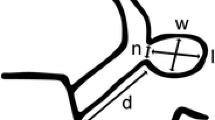Abstract
Background
The diagnosis and treatment of unruptured paraclinoid aneurysms has been increasing with the recent advent of diagnostic tools and less invasive endovascular therapeutic options. Considering the low incidence of rupture, investigation of the characteristics of ruptured paraclinoid aneurysm is important to predict rupture risk of the paraclinoid aneurysms. The objective of this study is to evaluate probable factors for rupture by analyzing the characteristics of ruptured paraclinoid aneurysms.
Methods
A total of 2,276 aneurysms (1,419 ruptured and 857 unruptured) were diagnosed and treated endovascularly or microsurgically between 2001 and 2011. Among them, 265 were paraclinoid aneurysms, of which 37 were ruptured. Removing 12 blister-like aneurysms, 25 ruptured and 228 unruptured saccular aneurysms were included and the medical records and radiological images were retrospectively analyzed.
Results
Of 25 aneurysms, 16 (64.0 %) were located in the superior direction. Five were inferior located lesions (20 %) and four were medially located lesions (16.0 %). Laterally located lesions were not found. The mean size of aneurysms was 9.4 ± 5.6 mm. Ten aneurysms (40.0 %) were ≥ 10 mm in size. Thirteen aneurysms (52.0 %) were lobulated. The superiorly located aneurysms were larger than the other aneurysms (10.3 ± 5.8 mm vs. 7.7 ± 4.9 mm) and more frequently lobulated (ten of 16 vs. three of nine). In a comparative analysis, the ruptured aneurysms were located more in the superior direction compared with unruptured aneurysms (64 vs. 23.2 %, p < 0.0001). Large aneurysms (36.0 vs. 7.9 %, p < 0.0001), longer fundus diameter (mean 9.4 ± 5.6 vs. 4.8 ± 3.3 mm, p = 0.001), dome-to-neck ratio (mean 1.8 ± 0.9 vs. 1.2 ± 0.5, p < 0.0001), and lobulated shape aneurysms were more likely to be ruptured aneurysms (13 of 25 ruptured aneurysms, 52.0 %, p = 0.001).
Conclusions
Rupture risk of the paraclinoid aneurysm is very low. However, superiorly located paraclinoid aneurysms appear more likely to rupture than other locations. Angiographically, more conservative indication for the treatment of paraclinoid aneurysm should be recommended except for superior located lesions.
Similar content being viewed by others
References
Abe M, Tabuchi K, Yokoyama H, Uchino A (1998) Blood blisterlike aneurysms of the internal carotid artery. J Neurosurg 89:419–424
Arnautovic KI, Al-Mefty O, Angtuaco E (1998) A combined microsurgical skull-base and endovascular approach to giant and large paraclinoid aneurysms. Surg Neurol 50:504–518, discussion 518–520
Beck J, Rohde S, el Beltagy M, Zimmermann M, Berkefeld J, Seifert V, Raabe A (2003) Difference in configuration of ruptured and unruptured intracranial aneurysms determined by biplanar digital subtraction angiography. Acta Neurochir (Wien) 145:861–865, discussion 865
Beretta F, Andaluz N, Zuccarello M (2004) Aneurysms of the ophthalmic (C6) segment of the internal carotid artery: treatment options and strategies based on a clinical series. J Neurosurg Sci 48:149–156
Boet R, Wong GK, Poon WS, Lam JM, Yu SC (2005) Aneurysm recurrence after treatment of paraclinoid/ophthalmic segment aneurysms–a treatment-modality assessment. Acta Neurochir (Wien) 147:611–616, discussion 616
Brilstra EH, Rinkel GJ, van der Graaf Y, van Rooij WJ, Algra A (1999) Treatment of intracranial aneurysms by embolization with coils: a systematic review. Stroke 30:470–476
Cawley CM, Zipfel GJ, Day AL (1998) Surgical treatment of paraclinoid and ophthalmic aneurysms. Neurosurg Clin N Am 9:765–783
D’Urso PI, Karadeli HH, Kallmes DF, Cloft HJ, Lanzino G (2012) Coiling for paraclinoid aneurysms: time to make way for flow diverters? AJNR Am J Neuroradiol 33:1470–1474
Day AL (1990) Aneurysms of the ophthalmic segment. A clinical and anatomical analysis. J Neurosurg 72:677–691
de Oliveira JG, Borba LA, Rassi-Neto A, de Moura SM, Sanchez-Junior SL, Rassi MS, de Holanda CV, Giudicissi-Filho M (2009) Intracranial aneurysms presenting with mass effect over the anterior optic pathways: neurosurgical management and outcomes. Neurosurg Focus 26:E3
Dhar S, Tremmel M, Mocco J, Kim M, Yamamoto J, Siddiqui AH, Hopkins LN, Meng H (2008) Morphology parameters for intracranial aneurysm rupture risk assessment. Neurosurgery 63:185–196, discussion 196–187
Diraz A, Kyoshima K, Kobayashi S (1993) Dorsal internal carotid artery aneurysm: classification, pathogenesis, and surgical considerations. Neurosurg Rev 16:197–204
Drake CG, Vanderlinden RG, Amacher AL (1968) Carotid-ophthalmic aneurysms. J Neurosurg 29:24–31
Ferguson GG, Drake CG (1980) Carotid-ophthalmic aneurysms: the surgical management of those cases presenting with compression of the optic nerves and chiasm alone. Clin Neurosurg 27:263–307
Fulkerson DH, Horner TG, Payner TD, Leipzig TJ, Scott JA, DeNardo AJ, Redelman K, Goodman JM (2009) Results, outcomes, and follow-up of remnants in the treatment of ophthalmic aneurysms: a 16-year experience of a combined neurosurgical and endovascular team. Neurosurgery 64:218–229, discussion 229–230
Guidetti B, La Torre E (1975) Management of carotid-ophthalmic aneurysms. J Neurosurg 42:438–442
Heros RC, Nelson PB, Ojemann RG, Crowell RM, DeBrun G (1983) Large and giant paraclinoid aneurysms: surgical techniques, complications, and results. Neurosurgery 12:153–163
Hoh BL, Carter BS, Budzik RF, Putman CM, Ogilvy CS (2001) Results after surgical and endovascular treatment of paraclinoid aneurysms by a combined neurovascular team. Neurosurgery 48:78–89, discussion 89–90
Huang MC, Baaj AA, Downes K, Youssef AS, Sauvageau E, van Loveren HR, Agazzi S (2011) Paradoxical trends in the management of unruptured cerebral aneurysms in the United States: analysis of nationwide database over a 10-year period. Stroke 42:1730–1735
Iihara K, Murao K, Sakai N, Shindo A, Sakai H, Higashi T, Kogure S, Takahashi JC, Hayashi K, Ishibashi T, Nagata I (2003) Unruptured paraclinoid aneurysms: a management strategy. J Neurosurg 99:241–247
International Study of Unruptured Intracranial Aneurysms Investigators (1998) Unruptured intracranial aneurysms–risk of rupture and risks of surgical intervention. N Engl J Med 339:1725–1733
Jin SC, Kwon do H, Ahn JS, Kwun BD, Song Y, Choi CG (2009) Clinical and radiological outcomes of endovascular detachable coil embolization in paraclinoid aneurysms: a 10-year experience. J Korean Neurosurg Soc 45:5–10
Juvela S (2002) Natural history of unruptured intracranial aneurysms: risks for aneurysm formation, growth, and rupture. Acta Neurochir Suppl 82:27–30
Kattner KA, Bailes J, Fukushima T (1998) Direct surgical management of large bulbous and giant aneurysms involving the paraclinoid segment of the internal carotid artery: report of 29 cases. Surg Neurol 49:471–480
Krisht AF, Hsu SC (2008) Paraclinoid aneurysms. Contemporary Neurosurgery 30:1–6
Lee CC, Hsieh TC, Wang YC, Lo YL, Lee ST, Yang TC (2010) Ruptured symptomatic internal carotid artery dorsal wall aneurysm with rapid configurational change. Clinical experience and management outcome: an original article. Eur J Neurol 17:1277–1284
Locksley HB (1966) Natural history of subarachnoid hemorrhage, intracranial aneurysms and arteriovenous malformations. Based on 6,368 cases in the cooperative study. J Neurosurg 25:219–239
Loumiotis I, D’Urso PI, Tawk R, Cloft HJ, Kallmes DF, Kairouz V, Hanel R, Lanzino G (2012) Endovascular treatment of ruptured paraclinoid aneurysms: results, complications, and follow-up. AJNR Am J Neuroradiol 33:632–637
Meling TR, Sorteberg A, Bakke SJ, Slettebo H, Hernesniemi J, Sorteberg W (2008) Blood blister-like aneurysms of the internal carotid artery trunk causing subarachnoid hemorrhage: treatment and outcome. J Neurosurg 108:662–671
Morita A, Kirino T, Hashi K, Aoki N, Fukuhara S, Hashimoto N, Nakayama T, Sakai M, Teramoto A, Tominari S, Yoshimoto T (2012) The natural course of unruptured cerebral aneurysms in a Japanese cohort. N Engl J Med 366:2474–2482
Nakagawa F, Kobayashi S, Takemae T, Sugita K (1986) Aneurysms protruding from the dorsal wall of the internal carotid artery. J Neurosurg 65:303–308
Nguyen TN, Raymond J, Guilbert F, Roy D, Berube MD, Mahmoud M, Weill A (2008) Association of endovascular therapy of very small ruptured aneurysms with higher rates of procedure-related rupture. J Neurosurg 108:1088–1092
Ogawa A, Suzuki M, Ogasawara K (2000) Aneurysms at nonbranching sites in the surpaclinoid portion of the internal carotid artery: internal carotid artery trunk aneurysms. Neurosurgery 47:578–583, discussion 583–576
Park HK, Horowitz M, Jungreis C, Genevro J, Koebbe C, Levy E, Kassam A (2005) Periprocedural morbidity and mortality associated with endovascular treatment of intracranial aneurysms. AJNR Am J Neuroradiol 26:506–514
Park HK, Horowitz M, Jungreis C, Kassam A, Koebbe C, Genevro J, Dutton K, Purdy P (2003) Endovascular treatment of paraclinoid aneurysms: experience with 73 patients. Neurosurgery 53:14–23, discussion 24
Rinkel GJ, Djibuti M, Algra A, van Gijn J (1998) Prevalence and risk of rupture of intracranial aneurysms: a systematic review. Stroke 29:251–256
San Millan Ruiz D, Yilmaz H, Dehdashti AR, Alimenti A, de Tribolet N, Rufenacht DA (2006) The perianeurysmal environment: influence on saccular aneurysm shape and rupture. AJNR Am J Neuroradiol 27:504–512
Sherif C, Gruber A, Dorfer C, Bavinzski G, Standhardt H, Knosp E (2009) Ruptured carotid artery aneurysms of the ophthalmic (C6) segment: clinical and angiographic long-term follow-up of a multidisciplinary management strategy. J Neurol Neurosurg Psychiatry 80:1261–1267
Shigeta H, Kyoshima K, Nakagawa F, Kobayashi S (1992) Dorsal internal carotid artery aneurysms with special reference to angiographic presentation and surgical management. Acta Neurochir (Wien) 119:42–48
Thornton J, Aletich VA, Debrun GM, Alazzaz A, Misra M, Charbel F, Ausman JI (2000) Endovascular treatment of paraclinoid aneurysms. Surg Neurol 54:288–299
Ujiie H, Tachibana H, Hiramatsu O, Hazel AL, Matsumoto T, Ogasawara Y, Nakajima H, Hori T, Takakura K, Kajiya F (1999) Effects of size and shape (aspect ratio) on the hemodynamics of saccular aneurysms: a possible index for surgical treatment of intracranial aneurysms. Neurosurgery 45:119–129, discussion 129–130
Vernooij MW, Ikram MA, Tanghe HL, Vincent AJ, Hofman A, Krestin GP, Niessen WJ, Breteler MM, van der Lugt A (2007) Incidental findings on brain MRI in the general population. N Engl J Med 357:1821–1828
Wiebers DO, Piepgras DG, Brown RD Jr, Meissner I, Torner J, Kassell NF, Whisnant JP, Huston J 3rd, Nichols DA (2002) Unruptured aneurysms. J Neurosurg 96:50–51, discussion 58–60
Wiebers DO, Whisnant JP, O’Fallon WM (1981) The natural history of unruptured intracranial aneurysms. N Engl J Med 304:696–698
Wiebers DO, Whisnant JP, Sundt TM Jr, O’Fallon WM (1987) The significance of unruptured intracranial saccular aneurysms. J Neurosurg 66:23–29
Winn HR, Almaani WS, Berga SL, Jane JA, Richardson AE (1983) The long-term outcome in patients with multiple aneurysms. Incidence of late hemorrhage and implications for treatment of incidental aneurysms. J Neurosurg 59:642–651
Yadla S, Campbell PG, Grobelny B, Jallo J, Gonzalez LF, Rosenwasser RH, Jabbour PM (2011) Open and endovascular treatment of unruptured carotid-ophthalmic aneurysms: clinical and radiographic outcomes. Neurosurgery 68:1434–1443, discussion 1443
Conflict of interest
None.
Author information
Authors and Affiliations
Corresponding author
Rights and permissions
About this article
Cite this article
Oh, Sy., Kim, M.J., Kim, B.M. et al. Angiographic characteristics of ruptured paraclinoid aneurysms: risk factors for rupture. Acta Neurochir 155, 1493–1499 (2013). https://doi.org/10.1007/s00701-013-1794-x
Received:
Accepted:
Published:
Issue Date:
DOI: https://doi.org/10.1007/s00701-013-1794-x




